mobile View, to the German Version tap the flag


- The Confederacy
- former confederation of states in North America
- 1861–1877 secession from the USA
- Abbreviation: CSA
• Flags
• Meaning/Origin of the Flag
• Coat of Arms
• Meaning/Origin of the Coat of Arms
• Map
• Numbers and Facts
• History
• Origin of the Country's Name
• Confederate Memorial Day
• President Jefferson Davis
• Flag controversy / flag discussion
1861 the southern staates Mississippi, Florida, Alabama, Georgia, South Carolina und Texas joined in an federation to preserve their interests, the "Confedered States of America". Other southern staates – North Carolina, Virginia, Kentucky, Tennessee, Missouri, Louisiana and Arkansas – joined later. After the lost war against the USA, the CSA were incorporated back in the territory of the USA to 1877.

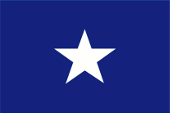
1861, "Bonnie Blue Flag",
(1810 · West Florida Republic, 1861 · State of Mississippi),
Source, by: World Statesmen,
Corel Draw 4





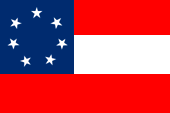
1861, The "Stars and Bars"
National flag,
Source, by: Corel Draw 4





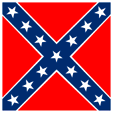
1861–1865, "Battle Flag"
War flag,
Source, by: Corel Draw 4



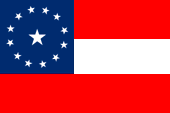
1861–1863, The "Stars and Bars"
National flag,
Source, by: Corel Draw 4



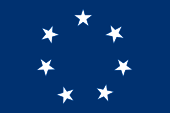
1861–1863,
Naval jack,
Source, by: Flags of the World



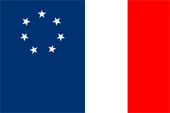
1861–1863,
Revenue Marine Customs Service,
Source, by: World Statesmen




1863–1865, The "Stainless Banner"
National flag,
Source, by: Corel Draw 4





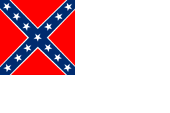
1863–1865,
Naval flag,
Source, by: Corel Draw 4





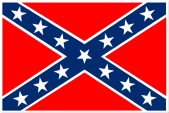
1863–1865,
Naval jack,
Source, by: Flags of the World





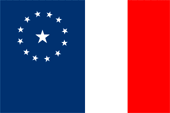
1863–1865,
Revenue Marine Customs Service,



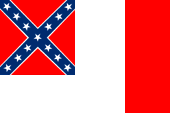
1865, The "Stainless Banner"
National flag,
Source, by: Corel Draw 4






Almost all member states of the later CSA had adopted their own independence-flags with the withdrawal from the USA. On 4th of February 1861 these states joined to the CSA, and it was hoisted the "Stars and Bars", the first flag of the CSA. The colors of the flag go back to the flag of the United States, and also the number of stars in the blue box in the upper corner indicates the number of member states. As more states joined, Kentucky in 1862 was the last candidate, the number of stars was changed up to 13. In September 1861 was introduced a war flag. The "Battle Flag" was square and showed a blue diagonal cross with white Stars on a red background, separated by a narrow white line from this. This flag has its roots in a flag that was used in 1860 in South Carolina. On 26th of May in 1863 was adopted a new national flag. It was called "Stainless Banner". It was a plain white flag with the "Battle Flag" in the upper corner. Because of its large white area this flag was apparently often seen as a capitulation signal, so that even on 4th of March in 1865, a vertical red stripe was added on the flying end of the flag.
Source: Die Welt der Flaggen

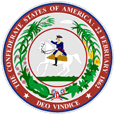
Coat of arms of the Confederate States of America,
Source, by:
www.arlingtoncemetery.net

The CSA used a seal. It showed George Washington on horseback, surrounded by a wreath of agricultural products. The inscription shows the name of the state and the date "22 December 1862," the day of the swearing in of President Jefferson Davis, below the motto of the state: "Deo Vindice" (With God as our protector).
Source: Wikipedia (DE)

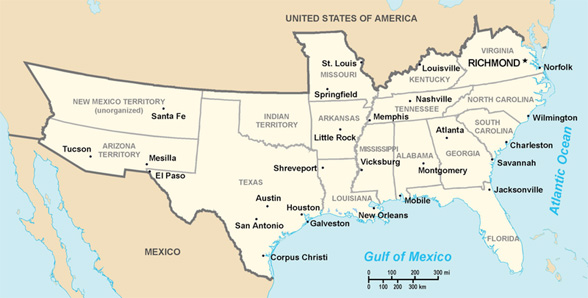
Source: Wikipedia (NO)

Area: 770.422 square miles
Inhabitants: 9.103.300 (in 1860), thereof 3.520.000 of African descent
Capital:
1861 · Montgomery (Alabama)
1861–1865 · Richmond (Virginia)
1865 · Danville (Virginia)
official Language: English
other Languages: Spanish, French
Currency: 1 CSA-Dollar = 100 Cents
Source: Wikipedia (D)

6th of November in 1860 · election of Lincoln to the president of the USA
20th of December in 1860 · South Carolina leaves the Union
January to February 1861 · further states leave the Union
4th of February in 1861 · formation of the CSA, captital Montgomery
8th of February in 1861 · indroduction of a confederation
9th of February in 1861 · election of Jafferson Davis to the president of the CSA
4th of March in 1861 · Lincoln's assumption of office
12th–14th of April in 1861 · shelling of Fort Sumter, start of the secession war
21st of May 1861 · transfer of the captital to Richmond
February 1865 · the Confederate Congress appoints General Lee as commander of all Confederate land forces
3rd of April 1865 · transfer of the captital to Danville
9th of April in 1865 · General Lee surrenders at Appomattox (Virginia) as commander of the Confederate Army of Northern Virginia, the other CSA Armies capitulate gradually until July 1865
6th of November in 1865 · the CSA warship and raider C.S.S. Shenandoah sweeps the flag as last CSA unit in the British port of Liverpool
18th of December in 1865 · the in January 1865 by the US Congress adopted 13th amendment to the constitution becomes valid, so that slavery in the area of USA is finally abolished
1865–1877 · "reconstruction", enforced return of the CSA states into the Union
Source: Wikipedia (DE),
World Statesmen

Until today, every US state has the right to left the USA if: A.) the Federal Parliament decides the secession by an absolute majority, and B.) the US Congress agrees with both chambers (senate and house of representatives) by an absolute majority the secession of the federal state.
Source: Jürgen Kaltschmitt

The CSA was a counter-project to the USA, which should be reflected in the name of the country. A confederation is a special covenant.
Source: Volker Preuss

The Confederate Memorial Day is celebrated in Texas on 19th of January; in Missouri on 6th of April; in Alabama and Mississippi on 24th of April; in Arkansas on 25th of April; in Florida, Georgia, Kansas and Arizona on 26th of April; in North Carolina and South Carolina on 10th of May; in Virginia on 30th of May; and in Kentucky, Louisiana and Tennessee on 3rd of June.
Source: dixierising.com,
timeanddate.com

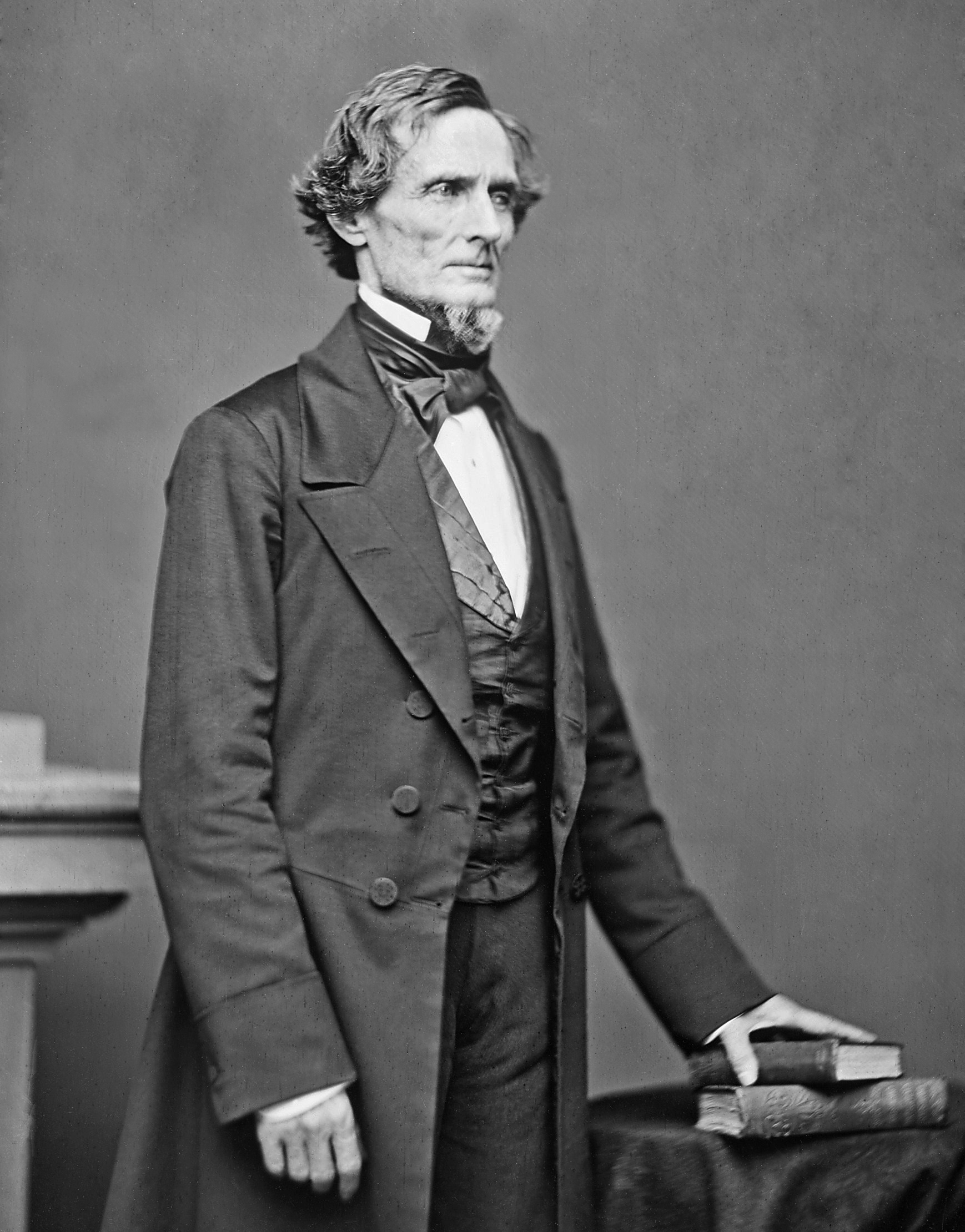
Jefferson Finis Davis (born on 3rd of June in 1808 in Fairview, Kentucky, died 6th of December in 1889 in New Orleans, Louisiana) was from 1861 to 1865, the President of the Confederate States of America (CSA). Previously, in the USA, he was Senator for Mississippi and 1853-1857 Minister of War. Jefferson Davis and his entourage were captured on 10th of May in 1865 near Irvinville, Georgia. On 24th of May in 1865 he was charged with treason. The war was fought by the USA with relentlessness and the utmost cruelty, and to end the civil war only an unconditional surrender of the CSA should be accepted. An honorable peace was not provided, and certainly not for the leader of the defeated country. In the following two years they tryed to make Jefferson Davis full responsible by remedies, a show trial was planned. However, they found out that neither Jefferson Davis nor the CSA had violated any law, it was also noted, that Jefferson Davis had done everything before the secession of the south as senator of Mississippi, to prevent the secession. Only when the secession was decided, he faced it - in his own words - "because it was too serious to be left to amateurs". His service as Minister of War of the USA(this official title was then common worldwide) he had exercised "best-possible". After a recognition of the independent CSA by the USA, Davis thought about an association of CSA and USA, with common foreign policy, security policy and external economic policy. After the first vicorious battle for the CSA in 1861, Battle of Manassas / Bull Run, Jefferson Davis had prohibited any persecution of the troops of the USA to "not to appear as an aggressor". As it became clear even in the court, a traitor must be an other. On 14th of May in 1867 he was released from prison, and the justice process was set in 1869. In 1978 Jefferson Davis was granted posthumously and again the USA citizenship. With this he is fully rehabilitated.
Source:
Jürgen Kaltschmitt,
Wikipedia (DE),
Volker Preuss

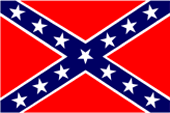
The Flag of the Confederation
About the so-called flag of the confederacy a hot dispute flared up in 2015, during which the flag became outlawed and was removed in the southern United States from many public buildings. Substance was the fact, that the flag should be a racist symbol, because the Confederate States of America (CSA) wanted to defend racism and slavery under this flag, as a kind of raison d'etat by the American Civil War. That may be partly true, but falls short, and the banishing from the public is nothing more than senseless, actionistic iconoclasm, which solves not the real problems.
The war broke out in 1861 because the existing mandatory congressional numerical balance between slaveholding and non-slaveholding US states, which came in danger by the incorporation of new states in the West, and not least by the election of Lincoln as president of the USA. Some southern states have therefore withdrawn from the Union, as a then still attributable constitutional right. And after the harsh measures of Lincoln, which – incidentally – did not follow the existing law, other southern states followed.
The mobilization was carried out by Lincoln, who really wanted the war. The South behaved initially defensive. What the often-mentioned bombardment of Fort Sumter really was - this so-called outbreak of the war - is not always known. The southern states wanted just to keep their independence, their laws and value system. Whether that had to please everyone, is another question. Fact was that the crew of Fort Sumter did not want to insinuate the troops of the CSA, and the CSA troops shoot the fortress, to force the crew to surrender. The crew negotiated, and it was agreed an honorable withdrawal, where the US-troops paraded, under arms, out of the fort. The CSA troops fired to salute, and by an artillery accident, happened the only two fatalities.
The southern states wanted their independence due to them by the constitution, just wanted to keep their laws and values system, did not want to be dictated by Washington of how they had to live, and demanded free trade, goods from Europe and Canada without annoying protective tariffs. The slavery was then already, mostly, internationally outlawed. However, the CSA intended for international recognition, especially by Great Britain and France. A prerequisite for that was the abolition of slavery. So it is not hardly surprising that the plans to abolish the slavery were already in the drawer, but the realization would have been a process, and not an abrupt break, but, the agrarian slave economy was the economic backbone of the CSA, and no one would break this itself suddenly.
The civil war ended in the liberation of the slaves, it was a consequence, but not the reason of the war. The war aim of the North was to restore the national unity of USA, with or without slavery. The proclamation of the emancipation was perceived in the South as pure hypocrisy, because slavery was so far existent and absolutely legal in some areas of the Union: In Washington (the Unions Capital) the slavery was abolished in April 1862 by decree, and the former owners were even financially compensated. In the Nabraska Territory the slavery consisted to 1861, in Delaware to December 1865, in the by the Union controlled areas of the Indian Territory to 1864, in Maryland to 1865, in West Virginia to 1865, in Missouri to 1863, in Kentucky and also in New Jersey to 1865.
Due to the relentlessness with which the North forced the war, a draconian reasoning became ultimately necessary, which Lincoln needed as categorically justification in front the people, and brought it into play as a war aim one year after the outbreak of the war. It is often overlooked, that the cause of the South – apart from the most white Southerners – was also defended by about 13.000 Hispanics, Tejanos and Mexicans, by about 10.000 Indians and 10.000 black soldiers, for the same wages as their white comrades. In 1890 still lived 3.573 black confederate veterans, receiving soldiers pensions. There were about 380.000 white slaveholders in the South, as well as approximately 3.000 slave-holding Indians and also about 10.000 slave-holding Blacks. The half of all slaveholders owned 1 to 5 slaves, and about one in twenty had more than 20 slaves.
As you can see, the cause of the South does not seem very plain or monochromatic. One should see the slavery from therefore not as a racist problem, but as an economic system. Whether this – as it was – was well, right or wrong, good or bad, black or white, is not to the debate in an scientific and historical perspective. It is simply not possible to dock today's moral standards on facts of the past, and to derive them as calls to action into the modern era. The states of the North and of the South treated ironically in full compliance with the respective constitutional laws. Therefore the responsible politicians of the CSA could not be prosecuted after the war by the victors, because they had violated no law. So there was not only Jefferson Davis – the President of the CSA – absolutely unmolested. The only one who repeatedly violated against the constitution, was President Abraham Lincoln itself. He also was always aware of that (more info about this? → click here).
The flag of the Confederacy stands therefore not (not only) for segregation and slavery, but further for the preservation of law and order, for the obligation to stand up for the constitution, and also for the right and the duty to defend it, self-organized, and with the weapon. This has justified and preserved the reputation as the rebel flag for the flag of the confederacy. It stands in this way for the desire to have a self-confident and independent life, maybe in conflict with one whatsoever mainstream. A symbol of racism or slavery this flag is not, anyway. Who says such things, must always bear in mind that there was legal slavery, under the flag of the USA, in the 89 years before these four years of civil war, and that for 32 years ships – which flyed the flag of USA – also transported human goods, slaves, to America. It should also be noted that the flag of the Confederacy is not even showed by the Ku Klux Klan in the South of the USA , there is used the flag of USA. The flag of the Confederacy is in the United States locally used by members of the Ku Klux Klan, but the flag is secondary and subordinated under the flag of the USA. Please read here: The Ku Klux Klan and the flag of the Confederacy
Source: Jürgen Kaltschmitt, Volker Preuss


![]()












































